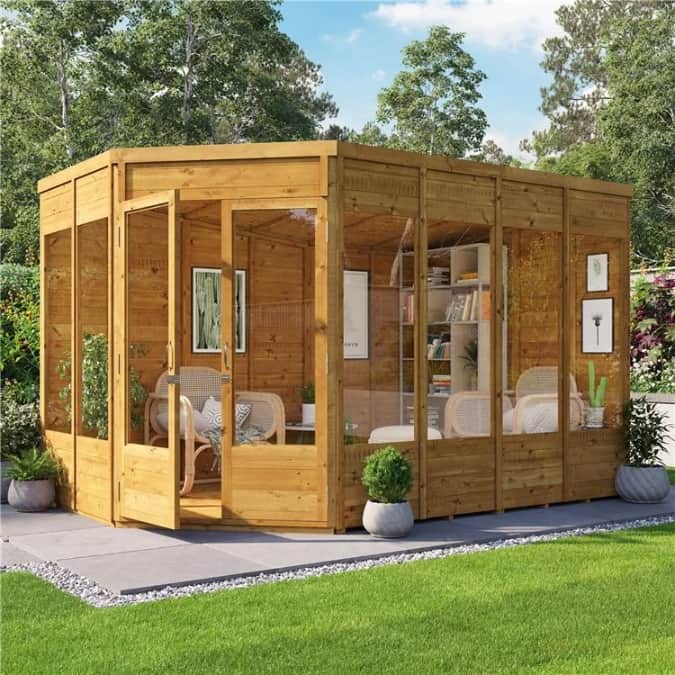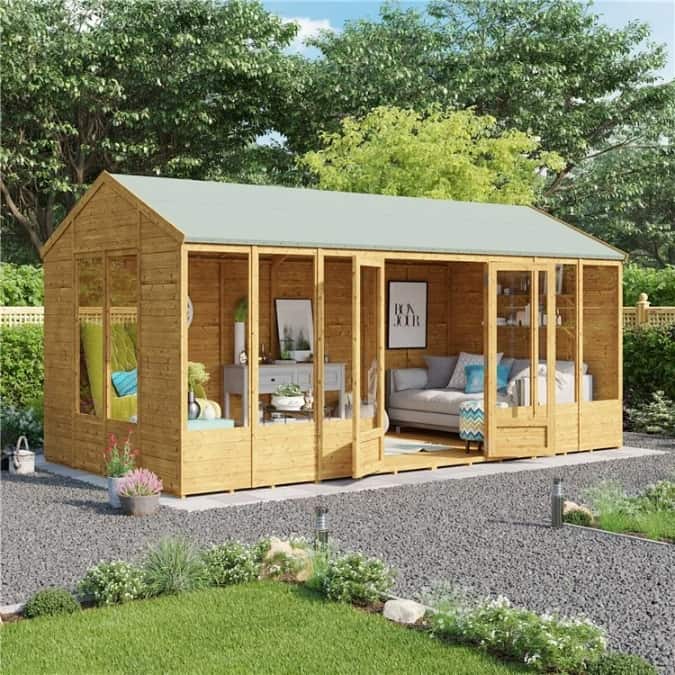Jump to:
As the temperatures rise, there’s nothing quite like retreating to a summer house. But when it comes to keeping it cool in this shifting season, that’s where the tricky part comes in. The last thing you want is for your beloved retreat to feel like a sauna. In this guide, we’ll walk you through a few ‘smart choices’ to keep it refreshingly cool and beat the heat!
Why do Summer Houses get too Hot?
One of the main features of garden summerhouses are their large windows which welcome large amounts of natural light into your space. And on most models, these windows will consist of a single piece of glass or shatterproof styrene glazing.
Single-glazed windows allow a high amount of heat to transfer through the panes. This works both ways; you might be familiar with how double-glazed windows help to keep heat in during cold weather. But double glazing also helps to reduce overheating during summer. In the case of a single-glazed summerhouse, direct sunlight on the windows is likely to heat up the interior of your summerhouse very quickly. On really hot days, this can mean that instead of a cool shelter to relax in, your summerhouse becomes more of a greenhouse.
So, remember: direct sunlight is the main cause of your heat problem.
How to cool down your summerhouse

As above, the main contributor to the heat inside your summerhouse is direct sunlight on the windows. So the first thing you want to look at is how to reduce the windows’ exposure.
Consider which direction your summerhouse faces. How much time do the windows spend facing the sun each day? If it’s a lot, expect it to be very warm indeed on the hottest summer days. By 4pm the interior could have spent so long being continuously warmed up that it’s virtually uninhabitable.
In contrast, a summerhouse which has spent the day facing away from the sun will be vastly cooler inside. While the wooden walls on the back and sides will have warmed up from receiving sunlight, the timber will hold onto this heat for the most part, reducing thermal transfer to the interior.
Moving your summerhouse to reduce sunlight exposure on the windows could be tricky. Aside from being a very heavy building, it would also need its base to move with it. Assuming that moving or rotating the building is out of the question, here are the more feasible options:
Insulate your summerhouse properly
Summerhouse insulation is an effective means of regulating internal temperature. However, this is more about preventing heat buildup rather than cooling down. An insulation job consists of thickening the walls, roof and/or floor to create a better barrier against outside conditions, using materials such as EcoFoil or expanded polystyrene. In warmer months, it stops the transfer of external heat into the interior space. This, in turn, maintains a cooler environment inside the summer house. It will also help to keep the building warmer in the winter, giving you a double benefit.
Double glazing the windows could also be an option, with some skill. Double glazed windows typically require quite thick walls, so on a standard 11mm summerhouse you might need to do something a little more makeshift. If you can get your hands on some additional pieces of styrene glazing, temporarily attaching these to the insides of your window frames can reduce heat transfer. However, containing that heat within the glazing requires a tight seal around the sides. This won’t be as effective as proper double glazing but could help as a short term solution.
To explore insulation options, read our guide on how to insulate your summerhouse. (Please note: installing insulation may count as a modification that can void the warranty on your summerhouse.)
Consider sealing gaps around doors and windows with weatherstripping to keep drafts out. Also, make sure you have the right ‘sizing’ for the air gap between wall and insulation material. These simple steps can reduce thermal transfer and block more heat from coming in from outside.
Summerhouse ventilation
Another method worth considering is ventilation. You don’t need anything fancy for this; simply opening the windows and doors will do the trick. By doing so, you can cool down the summerhouse by letting hot air escape and bringing in cooler air from outside.
It is best to open it up at the start of the day, before the heat can build up.
Install cooling blinds or curtains
Your next best bet to reducing direct sunlight on your summerhouse windows is to block it. You may have done the exact same thing inside your home to keep it cool. A wooden summerhouse makes it easy to screw on a curtain rail or a roller blind. Choose bright or reflective material to minimise heat absorption with a higher albedo.
Bonus lifehack: Tape long sheets of kitchen foil over the windows to completely reflect sunlight away. You might want to take this off when you’re actually inside the summerhouse, though.
Shade the summerhouse from outside
Casting shadows over your summerhouse windows is perhaps the simplest and most effective way to keep it cool.
It’s never too late to plant trees or tall shrubs which provide natural shade. Deciduous trees, especially, are handy in summer when they’re in full foliage. At the same time, they allow sunlight during winter when they shed their leaves. Just don’t plant them too close; moisture from plants can affect your summerhouse timber, and a falling tree is a huge safety hazard.
Installing retractable awnings, canopies, or a gazebo can create shaded spaces. Many of our customers have erected gazebos as an extension to the front of their summerhouse for the exact purpose of shade. Choose materials and designs that complement your summerhouse’s aesthetic. For instance, a pergola over your summerhouse patio. With its open roof design, it blocks direct sunlight while allowing a bit of it to filter through. This creates a pleasant dappled shade, which can be a perfect spot for relaxation.
Paint your summerhouse with reflective colours
Dark colours absorb sunlight and heat; bright colours reflect it and stay cooler. Remember this if your summerhouse spends a lot of time in direct sunlight. There’s a reason most Mediterranean homes are light-coloured.
Use Smart Landscaping for Cooler Surroundings

Smart landscaping uses strategic plant placement to naturally control ground temperatures. One effective way to do this is to add mulch around plants to keep the soil cool and moist. Using light-coloured rocks or paving instead of dark ones can also reflect heat away in the area around your summerhouse.
Are heat-tolerant plants effective?
Yes, heat-tolerant plants can help maintain a cooler environment around your summer house. They can withstand hot temperatures without withering. Think succulents, cacti, lavender, rosemary, and ornamental grasses. These plants are not only resilient to heat but also add beauty and texture to the landscape.
Tips: Watering is key to keeping these plants happy. Give them a good soak to encourage their roots to grow deep and make them more resilient to heat stress. Install drip irrigation systems to minimise water loss from evaporation.
Can green walls or trellises block sunlight effectively?
Absolutely! Greenwalls or trellises offer effective garden shade and contribute to cooling the area. These structures are typically covered with climbers, which act as natural sun blockers. As the plants grow and spread, they form a dense canopy that filters sunlight. This shading effect minimises heat absorption and keeps the surrounding area cooler.
Tips: Plant vines, such as jasmine or bougainvillaea, for optimal results. When building green walls or trellises, use wood, metal, or wire mesh. Ensure the trellises block direct sunlight from entering your summerhouse.
Add a fan or portable AC unit
This works as both prevention and a cure. If your summerhouse is full of hot air, a fan will help alongside the ventilation mentioned above. Simply place it somewhere near the back, point it at the open doors, and blast it on full. This will create airflow and circulation which pushes hot air out of the room.
Air conditioning is a more powerful but expensive option, and is most effective with the doors closed.
Of course, both these methods require an electricity supply. If you don’t want to go to the extent of installing electricity in your summerhouse (which could be a modification), you can use an extension cable from your house as a short-term solution.
With these tips, you can stay cool and enjoy your retreat even during the hottest summer days. Remember to optimise temperature regulation and consider shader and smart landscaping.
If you’re in the market for a summerhouse and haven’t chosen one yet, our summer house buying guide has everything you need for comparing models.
If you have any further questions, contact us and don’t hesitate to give us a call at 01909 768840. Next on your reading list: How to Clean Your Summer House Ready for Summer










